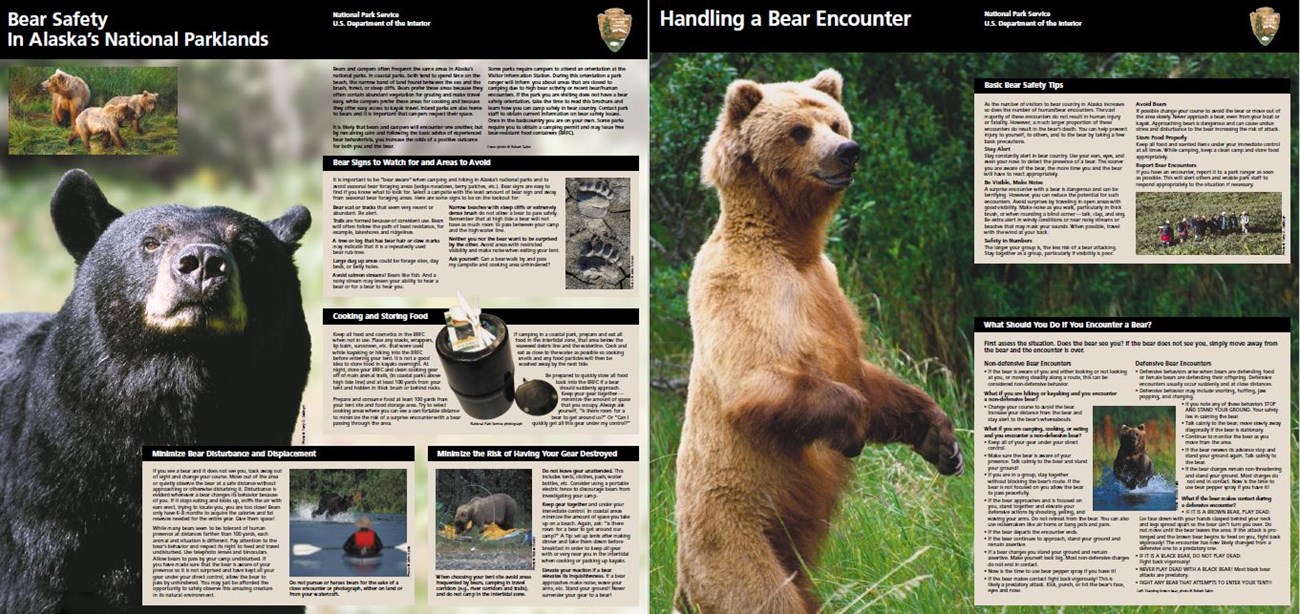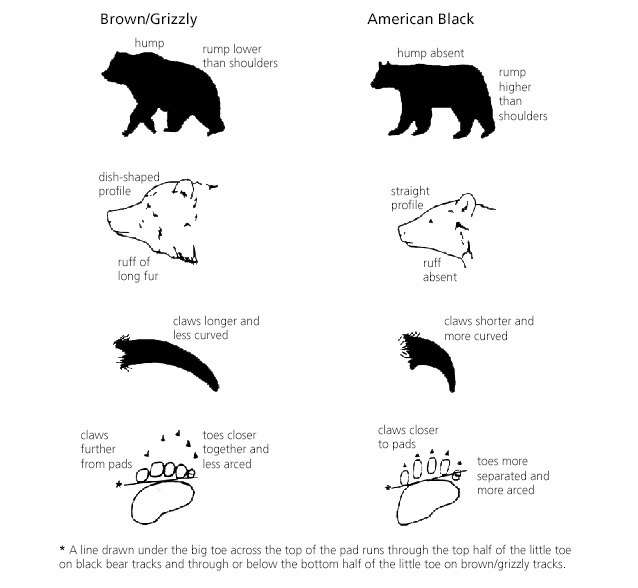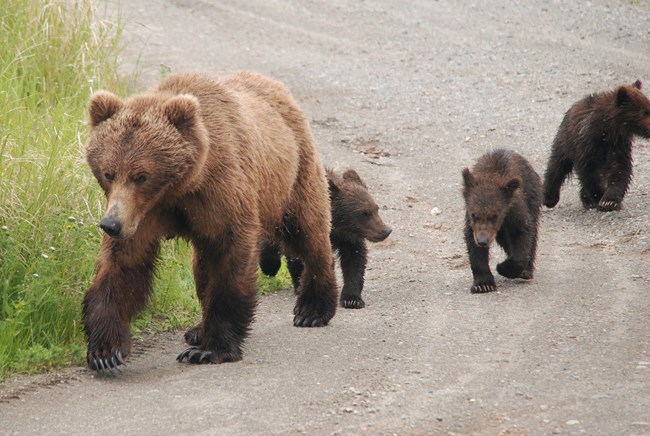
NPS Bear Encounter Form(fillable pdf format, 130 KB)

Illustration courtesy of Yellowstone National Park
Transcript
Hi there, my name's Stephens Harper. I'm a Ranger with the National Park Service in Alaska, at Wrangell St. Elias National Park and Preserve. It's best known as a stunning landscape of vast mountains and huge glaciers, but it's also home to black and grizzly bears.
More and more people are living, working, and recreating in Alaska than ever before. As a result, a steady rise in the number of bear encounters has occurred. This video will hopefully help teach you how to avoid encounters. It'll also help teach you how to properly react during an encounter based on the bear's behavior. We're going to be talking about bear safety today. That's really important if you're traveling through Wrangell's, because a lot of what you see behind me is bear country. We have black bears and we have grizzly bears. The difference between black bears and grizzlies are numerous factors. Color is not a good thing to try and determine whether or not you're looking at a grizzly versus a black bear. Black bears can come in multiple colors from brown, to almost blonde, to jet black. Grizzly bears can also come in a variety of color phases. Black bears are quite a bit smaller than grizzly bears. They, typically, have a more doglike face with a longer straighter snout and much larger ears, as opposed to a grizzly bear that has a much blockier, heavier head with, in proportion, much smaller ears. The other differences are that black bears have no prominent shoulder hump. When you're looking at the profile of a black bear, usually, what you see is the rump, of the rear end of the bear, sticks up higher than the shoulder. As opposed to a grizzly, who has massive shoulder muscles used for digging and has a much more prominent shoulder hump. Some of the other differences between black bears and grizzlies are that grizzlies have more of a dish-like face. When you look at their face and profile, it's more concave. Versus black bears are more convex or straight in profile. On the trail! Coming through. So to avoid surprising bears, when walking into an area that has decreased visibility, you want to make sure stay close together as a group and really pick up your volume before you enter thick brush or a forest. Whoa, guys a bear. Let's group up. Easy. Easy bear. Easy. Stay there. Get the pepper spray out. OK. Easy bear. Be cool, bear. Whoa bear. It's all right. Whoa bear. Stay there. It's all right. All right, looks like it's going away. Nice work guys. When you're walking out of the brush or wooded area into open country, if you have good visibility in all directions, you don't need to make nearly as much noise as you did back in the woods. But if you're looking out across the landscape and you see undulations in the territory, make sure to make noise when you come up to those gullies or draws. Because it could be hiding a bear. So if you're out in open country and you see a bear in the distance, the first thing you need to do is stop, stand your ground, let the bear know you're human, and gather your other hiking mates together, group up, make sure that you're in a nice tight group. If the bear approaches, curiously or in an aggressive manner, you need to make sure that you ready your deterrent, get your pepper spray out, and as the bear approaches closer, let it know that it's gotten as close as you want it to be. Ramp up the amount of noise you're making, yell at it. Step charge at it if you want to. And be prepared to deploy your pepper spray. It's coming a little closer. Let's ramp it up. Hey! Hey! Hey! Hey! Hey! Hey! He's coming. On three let's stomp. One, two, three, Hey! Come on! Come on! Oh! So if you're stepping out of the woods and you encounter a bear, what's the first thing you do? You stop, you gathered together, and you let the bear know you're human. So, hey bear, ho bear, calmly speak to the bear. Hopefully, that's going to deter it right there. It'll probably turn around and run off. If it doesn't, if it comes closer to you, make sure that everybody is working in unison. OK, guys let's get our bear pepper spray out. We might have to pepper spray this bear. If that bear gets any closer, folks we're going to start making a lot more noise, all right. Hey bear, ho bear, get out of here bear. Just know that the effective range of bear pepper spray is out to 30 feet. So if you do need to deploy your pepper spray, make sure that that bear is within that effective range. So setting up a camp in bear country is a lot different than when you're not in bear country. It's really important to make sure that you separate where you're sleeping from where you're cooking and eating, and from where you're storing your food. Hey, guys. Where do you think we should cook our food tonight? We're supposed to go downwind. So, probably about 300 feet that way maybe. And then for food storage, we're supposed to go triangular 300 feet, maybe that way? Does that sound good? Yeah, that sounds good. All right. Typically, if the territory allows, you should set up a triangle where you have your sleep tent here, your cook tent here, or food area, preparation area, and your food stored in a separate location. You want to make sure that the wind is not blowing the scent of your cooking towards your sleeping area. So that if a bear does smell your food, it's not drawn to where you're sleeping at night. Critically important is proper food storage. Bear resistant food containers are readily available. The National Park Service lends them out for free of charge at Wrangell St. Elias. And there are no trees in most of the area to hang food and keep it high enough to where bears can't reach it. Proper food storage is really one of the more important things. Bears have an incredible sense of smell. And they will seek out anything in their environment that smells different than what they normally come across, including your lip balm, your hand lotion, and, of course, your food. Bear resistant food containers are available at all the National Park Service visitor centers at Wrangell St. Elias. And you should take advantage of that, because not only is it really smart, but it's also a regulation. Statistically, 90% of all black bear attacks were from black bears that had obtained food from humans in the past. This is called food conditioning. When a bear gets food from people, it associates all other people with the possibility of getting a free lunch. This is bear pepper spray in a side holster. It's really easy to get to. You just simply lift up on the strap, pull the pepper spray straight out. I want to show you something here on the side of the label. You can see the expiration date on this can, 2017. You want to check that before you go on the field. The expiration date really does matter of these. Right here on top is the safety clip, slide it back with your thumb and then you're ready to spray. Hey bear! Get back bear! If you're attacked by a bear that's acting defensively, such as during a surprise encounter or a bear that's protecting its cubs or food, you don't want to fight back. You want to go to the ground, protect yourself, protect your head, protect your neck, protect your belly, curl into a ball. If you have a pack, pull it up like this, so that it's protecting the back of your neck. And remember don't fight back. The thing is we want to make sure that bear understands that you're not a threat. If you're attacked by a bear that's acting, aggressively versus defensively, you want to fight back. If you're knocked to the ground, you want to use everything you have. If you can get your pepper spray, use it. But if not, punch, kick, grab sticks, grab rocks. Remember if the bear is acting defensively, you don't want to fight back. If the bear is acting aggressively, you want to fight back with everything you have. I hope this video has been helpful and educational and not freak you out too much, because honestly bear attacks are incredibly rare. You're much more likely to be attacked by a dog than you are bear. So don't become bear-noid, just remember what you've learned in this video. Go out and enjoy your National Park, and have a good time.
Visit our keyboard shortcuts docs for details
Bear Safety while hiking and camping in Wrangell Saint Elias National Park and Preserve includes how to differentiate between Grizzly and Black bears, what to do if you encounter a bear, and the camping triangle of where to sleep, where to cook and where to store your food. 
NPS Staying Safe in Bear Country (video 30:36) Safety in Bear Country Society This is the primary video in the Safety in Bear Country video series, and is a major educational tool for anyone living, traveling, or working in black and grizzly bear country in North America. It includes the consensus opinion of leading experts on bear behavior and its relevance to human safety. Viewers will develop a better understanding of bear behavior and how this knowledge can help them to minimize the chance of bear encounters and bear attacks. The video stresses that a much greater degree of co-existence with bears is possible if people understand and apply a few safety principles.
Visit our keyboard shortcuts docs for details
Bear spray is proven to be highly successful at stopping aggressive behavior in bears. Bear Management Biologist Kerry Gunther walks through the steps to deploy bear spray. |
Last updated: June 15, 2023
